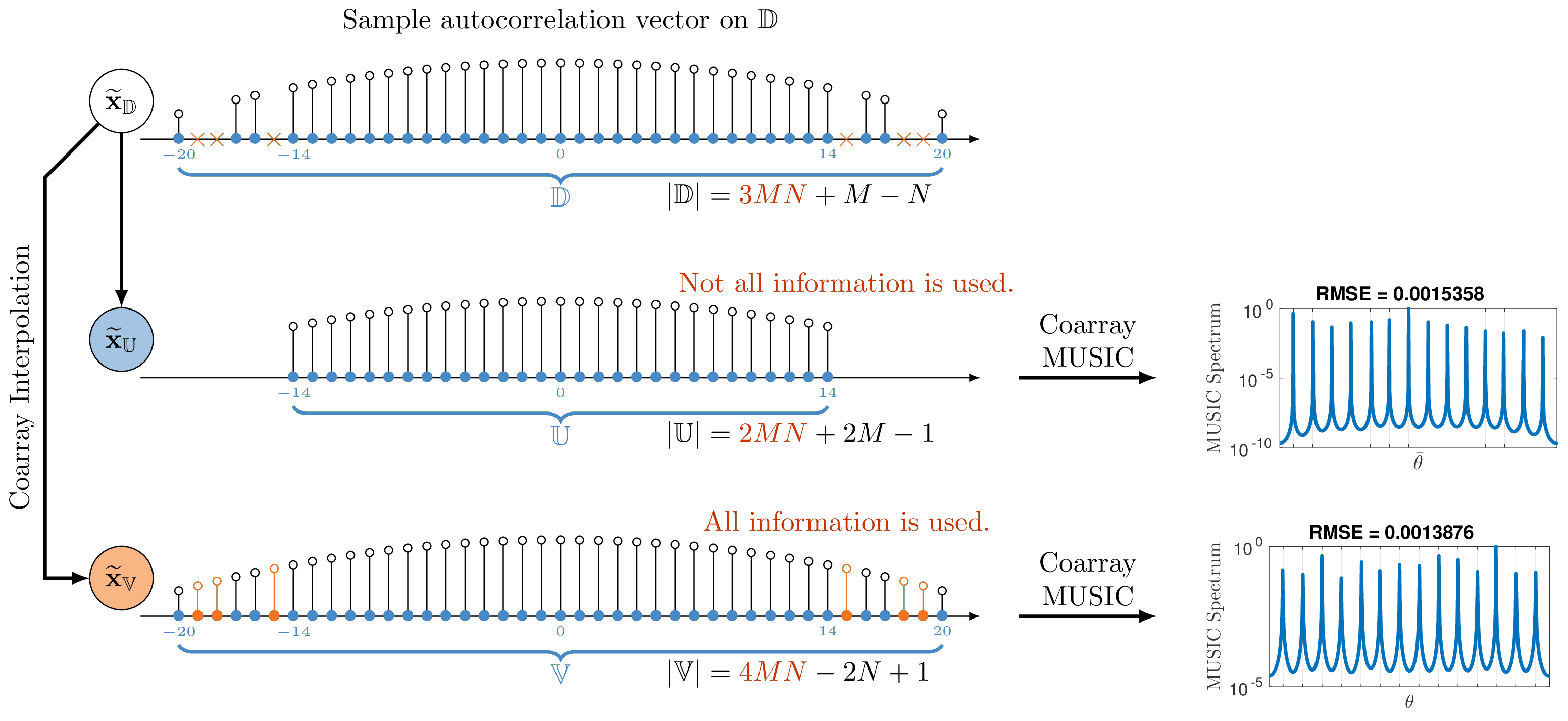Chun-Lin Liu – Topics – Coarray MUSIC and Coarray Interpolation
Sparse array design with reduced mutual coupling
DOA Estimation Based on Difference Coarrays

Illustrations for coarray interpolation and coarray MUSIC (View larger)
Coarray MUSIC Algorithm [1]
Sparse arrays such as nested and coprime arrays use a technique called spatial smoothing
in order to successfully perform MUSIC in the difference-coarray domain.
In this paper it is shown that the spatial smoothing step is not necessary in the sense that
the effect achieved by that step can be obtained more directly.
In particular, with  denoting the spatial smoothed matrix with finite snapshots,
it is shown here that the noise eigenspace of this matrix can be directly obtained from
another matrix
denoting the spatial smoothed matrix with finite snapshots,
it is shown here that the noise eigenspace of this matrix can be directly obtained from
another matrix  which is much easier to compute from data.
which is much easier to compute from data.
Coarray Interpolation [2]
Coprime arrays, consisting of two uniform linear arrays whose inter-element separations are coprime,
can resolve  sources using only
sources using only  sensors.
However, holes in the coarray prevent us from using the full coarray in the MUSIC algorithm for DOA estimation.
Through interpolation, it may be possible to use the remaining elements of the coarray
to increase the degrees of freedom beyond what is captured in the contiguous ULA section in the coarray.
Techniques like positive definite Toeplitz completion, array interpolation, and sparse recovery,
manage to include all the information in the coarray, but they demand extra fine-tuned parameters and
have individual drawbacks.
In this paper, a simple and tractable convex framework via nuclear norm minimization is presented.
This approach has no extra tuning parameters and overcomes several undesired issues of other techniques.
Numerical examples indicate that, in many instances, the proposed method not only
increases the estimation accuracy but also distinguishes more sources than other methods.
sensors.
However, holes in the coarray prevent us from using the full coarray in the MUSIC algorithm for DOA estimation.
Through interpolation, it may be possible to use the remaining elements of the coarray
to increase the degrees of freedom beyond what is captured in the contiguous ULA section in the coarray.
Techniques like positive definite Toeplitz completion, array interpolation, and sparse recovery,
manage to include all the information in the coarray, but they demand extra fine-tuned parameters and
have individual drawbacks.
In this paper, a simple and tractable convex framework via nuclear norm minimization is presented.
This approach has no extra tuning parameters and overcomes several undesired issues of other techniques.
Numerical examples indicate that, in many instances, the proposed method not only
increases the estimation accuracy but also distinguishes more sources than other methods.
Toolkit
Sample code (Last update: July 13, 2017)
main_coarray_MUSIC_interpolation.m: The main program.
weight_function.m: Given the sensor locations, compute the weight function on the difference coarray.
sample_covariance_to_difference_coarray.m: Given the sensor locations and the sample covariance matrix, return the sample autocorrelation vectors or the augmented covariance matrices defined on the difference coarray.
coarray_MUSIC.m: Given the sample autocorrelation vectors on the difference coarray, evaluate the coarray MUSIC spectrum and estimate the normalized DOAs.
Please see the comments in these files for more details.
Our Papers
C.-L. Liu and P. P. Vaidyanathan, ‘‘Remarks on the Spatial Smoothing Step in Coarray MUSIC,’’ IEEE Signal Processing Letters, vol. 22, no. 9, pp. 1438-1442, Sep. 2015.
(DOI)C.-L. Liu, P. P. Vaidyanathan and P. Pal, ‘‘Coprime Coarray Interpolation for DOA Estimation via Nuclear Norm Minimization,’’ in Proc. of 2016 IEEE International Symposium on Circuits and Systems (ISCAS 2016), pp. 2639-2642, Montreal, Canada, May 2016.
(DOI) (Full text) (Slides)